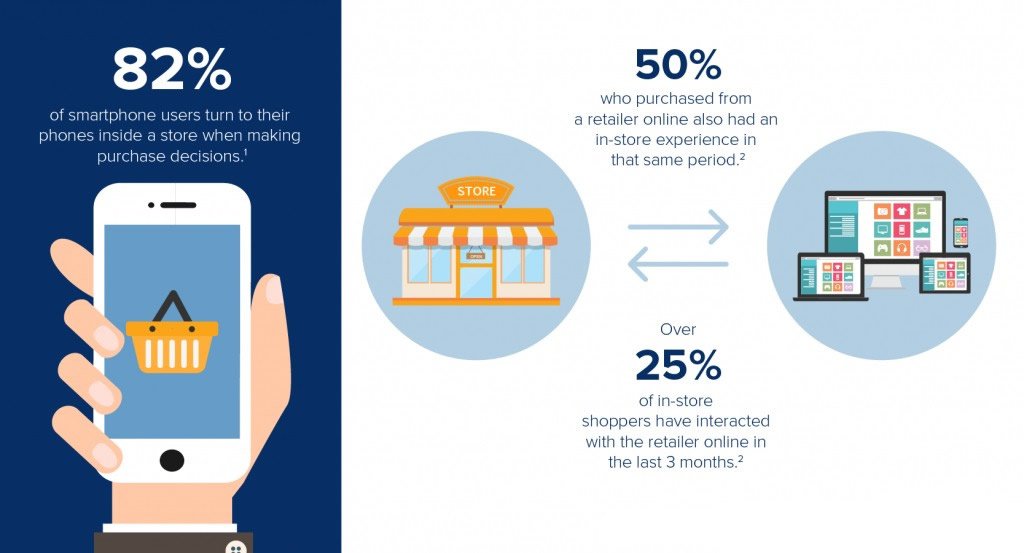To this point, I believe nobody doubts that smartphones are essential elements ir our lives. It is the first thing we look when we get up and the last when we go to sleep.
It has evolved from a simple “smart” mobile phone to a vital tool: check your e-mail, use it as a personal trainer, watch your favourite shows, look for a new job, talk to our friends through social media, make bank transfers and a long list of possibilities.
It was only a matter of time that we would start to buy through our mobile devices. And, according to the numbers, we are taking this seriously.
In a world with approximately 2000M people using a mobile phone (it is estimated that in 2018 there would be 2500M), 86% of smartphone users plan to make purchases through it and 81% searches information of the products they are interested in.
Maybe you should consider how this affects to your online shop.
M-commerce data
M-commerce represents approximately a third part of the e-commerce in the world. Japan and South Korea are at the top of the list of countries with more transactions through mobile devices, reaching the 50%.If we observe every retail area closely, fashion and luxury industries beat the 32% of mobile transactions, while home equipment industry is the last with a discrete 16%.
M-commerce has grown a 68,8% in Spain in 2015, and now represents up to a 30% of the online commerce market quota in our country. This makes us the fourth global market for mobile purchases and the third in Europe.
In terms of devices, Android smartphones and iPad are the most used (11% and 9% of the total e-comerce transactions, respectively). Curiously, Android and Apple tablets have the higher ratios of conversion (2,3% and 2,7% respectively).
Moreover, you should consider that smartphones are the most popular devices to buy in the morning, while tablets are used during the afternoon and night.
This shows us the relevance the mobile devices can have in your sales revenue, and that you should optimise both your website and your customer acquisition campaigns for this devices.
M-commerce tendencies
We don’t like referring to m-commerce itself as a tendency, as it has become a reality had to ignore both by big companies and SMEs or even entrepreneurs.
However, it is obvious that m-commerce present different tendencies during its evolution in 2016:
Online and offline worlds converge towards omnichannel and cross-channel
50% of end users purchasing online have previously been at the shop and 25% of users purchasing at brick-and-mortar shops have interacted with the online shop during the previous 3 months.
Responsive websites will replace mobile apps
Due to the excessive amount of apps we have on our mobile phones, their elimination rate is quite high. That makes much more convenient to create a responsive website adapted to any mobile device which can offer a good user experience and every function available.
Users use different devices
Statistics show us that 2 out of every 3 Americans use at least 2 mobile devices and that 33% have a smartphone and a tablet, in addition to a laptop.

M-commerce advantages
We have already looked over the data that support both the use of mobile phones in online shopping and the tendencies on m-commerce, so now we need to check the advantages it has for your shop in operational and marketing strategies:
- Lower shopping process times.
- Creation of specific offers for mobile users.
- Creation of campaigns with BIDI codes.
- Lower operational costs.
- Gathering of customer’s data as well asgeolocation data.
- Direct interaction with specific users.
As you can see, this is not only good for users, it also benefits your e-commerce.
So… Do I really need to adapt my shop?
Absolutely. In fact, m-commerce is here for good and if you ignore it, that will only mean fewer sales for your shop: customers will try to access your website from their mobiles devices and will just leave if it is not adapted correctly, so that will diminish your conversion rate.
Moreover, this will negatively affect the SEO strategy of your website. Google introduced some modifications on its search algorithm a while ago, and now it prioritizes those websites adapted for mobile phones, especially the ones created under the design specification AMP (Accelerated Mobile Pages).

On the other hand, studies show us that by 2020 the website user experience in websites may surpass the relevance of the product as the main distinguishing element between brands.
Finally, there are other issues that may provoke in your customers the need to leave your shop when accessing from mobile devices, such as excessive loading times, unreasonable data consumption or writing difficulties.
However, this change is not only necessary for e-commerce. Any web-based platform should adapt to this reality sooner or later if they want to maintain their positions.
Even us had to modify Boardfy due to the growing number of users that access from their mobile phones, so that they can change prices and control the competitors whenever and wherever they want.
Conclusion
To sum up, it is more than necessary to assume that m-commerce is becoming more and more relevant for online commerce all around the world, and that the current user experience in online purchases has a lot to do with smartphones and tablets. Customers want to have access to any product anytime and anywhere, and mobile phones are the most suitable devices for that.
The number of sales made from mobile devices will progressively increase and e-commerce managers must focus on m-commerce strategies to complement their global sales plans.
From Boardfy we encourage you to reconsider your current opinion about m-commerce and to adapt your shop to this new reality.




